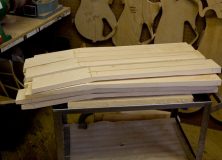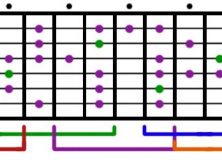
Read Time 16 Minutes
Miroslav Tadic
Miroslav Tadic is a guitarist’s guitarist. As an acoustic player, he mixes elements of his classical guitar background with multiple influences (including Baroque, Blues, Brazilian, Eastern European and Flamenco music) into a divinely devastating delivery that is both passionate and cerebral.
Check out this duo with harmonica virtuoso Howard Levy for some stunning playing.
(“Jovano, Jovanke” w. Howard Levy)
Miroslav also has a truly original voice as an electric guitarist as well that is instantly identifiable in diverse contexts. His recent score for the Invisible Writing dvd (with Single Wing Turquoise Bird) showcases both his ambient experimental side as well as his post-Hendrix take on Macedonian music. One of Miroslav’s regular gigs involves playing the Mothers of Invention era music of Frank Zappa with the Grandmothers of Invention (including members Tom Fowler and Napoleon Murphy Brock with Don Preston as a special guest from the original Mothers of Invention band and drummer/percussionist Chris Garcia).
.
Here’s a clip of the band playing Frank Zappa’s Pygmy Twylyte
The Gear Interview With Miroslav

In addition to his musical offerings (which includes a 26 cd discography, published guitar works, a full time faculty position at California Institute of the Arts, multiple tours and performances), Miroslav makes his own guitars and has made effects, speaker cabs and amps as well! Miroslav was kind enough to sit down with me on several sessions and talk about many aspects of his playing and perceptions on music, but since Guitar-Muse readers are really into tone and gear we decided to focus part one of this interview on the genesis of his instruments, Miroslav’s relationship to sound and his current electric and acoustic live setups.
.
S: How did you get into building electric guitars?
M: I started getting more seriously into electric in the mid-80’s around the time of the Dark/Bracha period. At the time I was playing a Strat. Just for the record, Son of Slavster and all of the CMP and Enja records Dark:Tamna Voda, The Snake Music, Let’s Be Generous and Loose Wires) were done on a Strat. I started using my own guitars around 2000. I’ve played them a lot, with the Grandmothers and Rade (Miroslav has released two recordings with actor Rade Šerbedžija), but the only electric records I’ve made since then are Invisible Writing and the ones with Rade. I’m really happy with the sounds of those records, but they’re not really heavy electric recordings.
I really liked the Strat but I didn’t like the neck and the spacing. When I found out that Warmoth sold individual parts, including a wider neck that was a direct replacement for a Strat, I ordered one. Have you ever ordered anything from them?
.
S: No I haven’t.
M: They make really great stuff. Very high quality. I got the neck in the mail and I was just blown away by how well made it was. I really loved that neck and decided I wanted to make one myself. The neck was really the main issue because classical guitar has always been my main instrument so when I started playing enough electric guitar, the spacing of the left hand was getting to be problematic for me and I started being imprecise on both instruments…More so than usual (laughs). So I was thinking about this idea of having the left hand only having to remember one set of spacing for strings, and decided I wanted to first try to build a practice neck. The idea wasn’t to make something that would be used on a guitar (there was no truss rod for example), but was just to make something that I could practice building techniques on.

S: How did you go about learning how to do that?
M: I read a lot of books. I was fortunate because I had access to the super shop at CalArts (which is a large workshop area with a lot of equipment and machines for building) and also got some advice from (CalArts faculty member and Super Shop head) John Reed. For my first build, I decided to keep it really simple. I bought a pre cut/slotted fingerboard from Warmoth and then some poplar from Home Depot and made a neck. There wasn’t a truss rod or anything, so it wasn’t functional but I learned a lot by doing that (including that I could actually do it!) I still have it. It’s hanging in the garage right now…in the museum (laughs). Except for the truss rod, the neck has essentially stayed the same.
.
S: Could you talk about the tools involved for a moment? It’s something that often gets glossed over in building tutorials, but it’s an important area.
M: The first important thing to mention is that the one thing that you can’t get from a book is how to use tools. The first step, in any part of a building process is gaining knowledge of the tools. Every tool that you use to make a guitar can grievously injure you if not kill you.
.
Another thing to remember is that each book shows you a little but nothing shows you the full thing. There are things I’ve gone back and read once I’ve done something and thought, there is no way that you would ever do this correctly based on this description.
.
You have to have a foundation in things. You can’t just do it your own way. You need to become familiar with tools really really well, and you need to follow the procedures in using them religiously and only use the tools that you understand well. It’s better to understand a couple of tools really well and use them for a lot of procedures than to partially understand a bunch of tools even if they’re more appropriate for the procedure. Even if it might not be the ideal tool, if you understand it really well, it’s better to use that than use something that you haven’t mastered.
.
S: At CalArts there’s a built in system for a mentor. Students get assigned a faculty member who becomes your mentor and then you have a specific relationship with this mentor as someone who helps guide you through this process. Can you talk about mentoring at all in this area?
M: I’m really not a builder, so I don’t have the experience to teach people. I mean I’ve been building instruments for 10 years which is a considerable amount of time, but that’s something I do on the side. But if that was something that I was doing actively, then I probably would have been going to shows and symposiums and apprenticed with someone. But I can only speak about my own experience and from that, I can say I’ve learned a lot from books.
.
When I look back at it, I haven’t had any formal training but I’ve checked some people out and I’ve spent some time in shops watching people. I really feel again that once you are confident with tools, if you’re patient and you have some money you can be on your way. The money’s important, because it’s not cheap to even buy the wood and some hardware for the guitar. In parts alone, you might spend as much money as you would on a pretty decent factory made guitar. There’s also a lot of trial and error. You might buy your first maple neck blank for $35, and you might screw it up in 3 seconds and that thing will be gone. So you’ve got to be ready to do things over again and to go through some material before you succeed. I think that you can do it really well. Once you start to work from the books you’re going to find in the areas in which you’re interested in checking out how somebody does it. And then if you get really into it then it’s time to apprentice with someone to spend 3-6 months at least working for somebody in the shop and just doing whatever they tell you and observe what they do.
.
S: Getting back to your guitars, let’s move away from the neck and talk about the evolution of the body.

M: Well…it’s sort of a modified Tele shape with a wide lower bout which I took from Flamenco. It’s been chambered to help with the weight and the sound. To me, light weight is synonymous with good sound.
S: Even with the body chambering, I notice that they balance really well when sitting down.
M: I guess I got something right then! (laughs)
S: Let’s talk about pickups briefly. Are there any constants?
M: I usually use hum cancelling single coils like a Bill Lawrence L-280S, Joe Barden S-Deluxe or a DiMarzio Area 58 or 61 in the neck position. I don’t use the bridge pick up that often, but when I do I tend to want something more extreme. I’ve thrown in things like a Bill Lawrence L500XL, Seymour Duncan TB-10, DiMarzio X2N or something similar.
.
Amps and Gear

S: We talked about the guitars quite a bit but we didn’t talk about the amps that much. What was the evolution of your amplification setup?
M: Well…yeah we can talk a little but about it. I’ve built a handful of amps (5-6) from 3-50 watts but I’ve never really been happy with them. I haven’t really had the time that I would really need to put into it, or to study electronics more deeply at the level I would need to really know it. It’s been more of a sort of hands on tinkering and experimentation.
.
S: Is there something specific you’re looking for in terms of sound?
M: (long pause) It’s really kind of hard to express what I’m looking for. I’m the kind of player that doesn’t really expect a lot from the amp because I’m trying to make music with my hands and the guitar. So either I haven’t really developed a keen way of judging amps or I haven’t developed a specific terminology to accurately describe what I’m really looking for. There’s a lot of stuff that I don’t like or there’s a lot of stuff I think is okay and for me okay is what I’ve been working with. My taste has changed. I had a very trebly sound when I was younger, I was a Strat guy and really into the clean Strat sound. I still love that sound but I don’t have almost any use for it these days because it seems to me to be so specific somehow even though it’s used by a lot of different people in a lot of kinds of music.
So in terms, of a clean sound I’m interested in more of a darker sound, but that’s also clear. It’s not distorted but clean and fat and also has definition. (laughs) So there you go.
.
S: But are there any kinds of hallmarks or benchmarks of tone that you have? Some people have something specific like “Eric Clapton Blues breakers era” that they have as a guide for what you’re looking for. Do you have anything like that?
M: That’s an interesting question because it ties into my whole approach. I like everybody’s sound because everybody’s sound is a great sound for them but it’s not necessarily the sound that I want because I’m not that person and I’m not playing their music the way that they do. For me the sound is not a separate thing. So I might say, “I really like the Jimi Hendrix sound of Band of Gypsies” – but what am I going to do with those sounds? Also, it’s not just the sound – it’s everything about it. It’s the sound, it’s his playing, it’s who he’s playing with, it’s the room he’s playing in and it’s the music that he’s playing. So there are a lot of great sounds, but I haven’t copied other players (and there are some great players with really original sounds who can also play like other people – somebody like Gary Moore who could play like anybody else). But I can’t do that. I mean I can play other people’s music but it’s not the same.
.
That’s why it’s hard for me to have benchmarks… I mean I do have benchmarks of my own sounds. There are things of mine I listen to and think, “Oh that sounds good” and that judgment is made on the observation that it’s good for me – but I’ve only been sort of getting into that lately. There have been a few sounds that I’ve heard that I really really like. There was particularly one sort of clean sound that I heard….but it was only one time on that one song and it was somebody that was playing slide. It was like a sarode type of sound on the guitar. This was beyond this idea of this sound is tied into this music and this was more like, “oh man… there’s a sound that I really like.” and it had those qualities that I mentioned. So it’s fat – but it’s not dull and it has a certain kind of dimension. It has a three dimensionality to it (of course not counting effects – but just the sound itself). It was like a ball instead of a pie.
.
S: Sonically is there a point of continuity of what you look for in acoustic timbre and electric tone? Is the context the thread that goes between the aesthetic of what makes a good acoustic versus a good electric tone?
M: I’m just realizing as you asked me these questions that I totally can’t separate sound from the actual music. So I don’t even think of it that way. What’s most important is how you use the sound to make music and how you shape the sound to make a phrase. From the standpoint of technique, I have a very talented student right now who’s a great Flamenco player and he’s started taking up electric guitar but the techniques are really incompatible… The beautiful sound it gives you on a Flamenco guitar sounds horrible on an electric. So he’s been realizing that and modifying his technique for electric guitar.
.
I’ve been getting much more into the tone production on electric guitar lately, because my main instrument has been nylon string guitar. I’ve had an understanding of sound and sound production with that instrument much clearer – much more how to break it down for myself. But with the electric guitar, I couldn’t really break it down – not until maybe a few years ago when I started to understand certain things about it. I’ve found that there is a similarity to sound but I’m also finding that the ways to produce that sound in terms of what both hands are doing is really different between electric guitar and nylon string. I think that there is much more similarity between acoustic steel string and electric guitar in terms of how you hit the strings but with nylon string – it’s really different.
.
Consequently I’ve been getting much more of the sound that I want for electric guitar. I’ve been using a lot more of the tone control for electric. You know, before I just ignored the tone control – I think I even had it bypassed on some guitars because I was thinking, “What’s the difference? It’s just got to be up all the way.” As an acoustic player, you shape all the sound with your hands but on electric it’s much more complex. I’ve been using the tone control a lot in recent years to really shape the sound, to get what I want (sonically), to get the amps to respond the way that I want them to and to adjust them to different rooms. I’ve also been playing with my thumb a lot – using the flesh of my thumb and just hitting the string toward the body of the guitar in more of a down stroke into the body than an out stroke. On classical guitar it would be called a rest stroke. I think Wes Montgomery played a lot like that and I really like that sound. That’s not something that would work on nylon guitar because it would sound very dull. On nylon string I also play with of thumb but I use edge of the nail a lot which is a Flamenco technique. If you use that technique on electric guitar (unless it’s for a radical effect or something like that) – it just sounds terrible.
.
S: Do you find yourself making technical adjustments acoustically live based on amplification or live sound production?
M: You know I’ve been fortunate in terms of acoustic guitar. I had a cool gig in the late ‘90’s playing acoustic guitar with Maria João, and that was the only time that I really had to play nylon string in a somewhat unnatural context – which was with a grand piano and a drum set. It was a small drum set, but even so it was really difficult from the amplification standpoint and it limited what I could do musically.
.
Since then I’ve played very large venues but it was always with just another guitar like with Vlatko or voice like Rade or playing solo. So my approach to that is I’ve never had a pickup in my acoustic guitar (and I still don’t) but I would probably use one if I played in a group context like that again, of course, I’d blend it with a mic sound. But I can just play with mics and mic placement in a good PA system. As a matter of fact, for people who are into gear or who are interested in this there is a really good clip on mic for guitar that’s made by a Danish company called DPA. They make a series of them; one is for horn, one for strings, guitar, etc…. It’s not cheap (Approximately $500-$600) but it’s a really good sounding mic. While it’s a clip on, it’s not clipped in the soundhole so you don’t get that super close sound – so you have some distance (maybe 8”) in the guitar. It clips onto the side of the guitar. I haven’t toured with it a lot – the side clip is the only thing that may not be made so well.
.
Otherwise I travel with this Russian Oktava MK-012 mic. They’re really great mics – similar to a Neumann KM 84s but much less expensive. It’s like a $200 mike, so if you break it you’re not out a grand or something like that.
S: What amps and effects are you currently using?
M: With the Grandmothers, I have the venue provide a Fender twin and a Vox AC-30 and then just use my pedal board in front of that.
.
The pedal board changes but it includes a t.c. electronics compressor-sustainer (or a Way Huge Saffron Squeeze), a Line 6 Otto Filter (or my own EF filter), my own custom wah-wah (based on a modified Craig Anderton Super Tone Control), a Danelectro Tuna Melt (or Voodoo Labs Tremolo), my own 4 stage phase shifter (based on the Anderton design) or Voodoo Labs Micro-Vibe, a Blackstone Mosfet Overdrive, an Octave Fuzz (based on the Anderton design), an Ernie Ball volume pedal, the Line6 DL4 and the TC Electronics Hall of Fame Reverb.
.
For recording, I’ve been really getting into the Bambino head from a company called Reason. I also have a 1962 Fender Princeton, a 70s Silverface Fender Vibro-champ and a Marshall JCM800 head with added foot-switchable Fender style clean channel.
S: What external speakers and speaker cabs are you using?
M: I have 2 Pearce cabs one with an EVM12L and one with a Celestion Vintage 30. I also have 2 custom cabs I made. One has a Celestion Vintage 30 and a THD 10″ and the other has Jensen NEO10-100s in it. Finally I have a Marshall JCM800 4×12 with stock speakers
S: What acoustic models do you play?
M: My main guitars are a 1987 Manuel Bellido Flamenco guitar (blanca) and a 1976 Jose Ramirez classical (1a). I also have a Sab-Mar custom-made Flamenco baritone guitar, a Martin OM-based steel string I built by myself and a 1939 National Steel single cone.

S: Strings?
M: For electrics I use D’Addario .010s for Electric and .011s or .012s for baritone. I use normal tension strings on Nylon. Galli for the bass strings and then for the treble I use Galli Titanio.
S: Finally, for people who want to get into building their own guitars or amps are there any books you could recommend?
M: There’s something to learn from every book published on the subject, so I’d recommend checking out as many as possible, especially if you don’t have direct guidance from an experienced luthier. Some of the more complete ones are Guitar Making Tradition and Technology by Cumpiano and Natelson for acoustic guitars and Make Your Own Electric Guitar by Melvin Hiscock for electric.
.
For amps I’d recommend The Ultimate Tone (TUT) series by Kevin O’Connor (Power Press Publishing, London, Canada).
.
Thanks again for your time Miroslav!
.
In part 2 of this interview, we’ll talk about Miroslav’s work as a highly influential and inspirational teacher at CalArts, his new releases, film score, innumerable musical collaborations and his published concert pieces on Doberman-Yppan.





